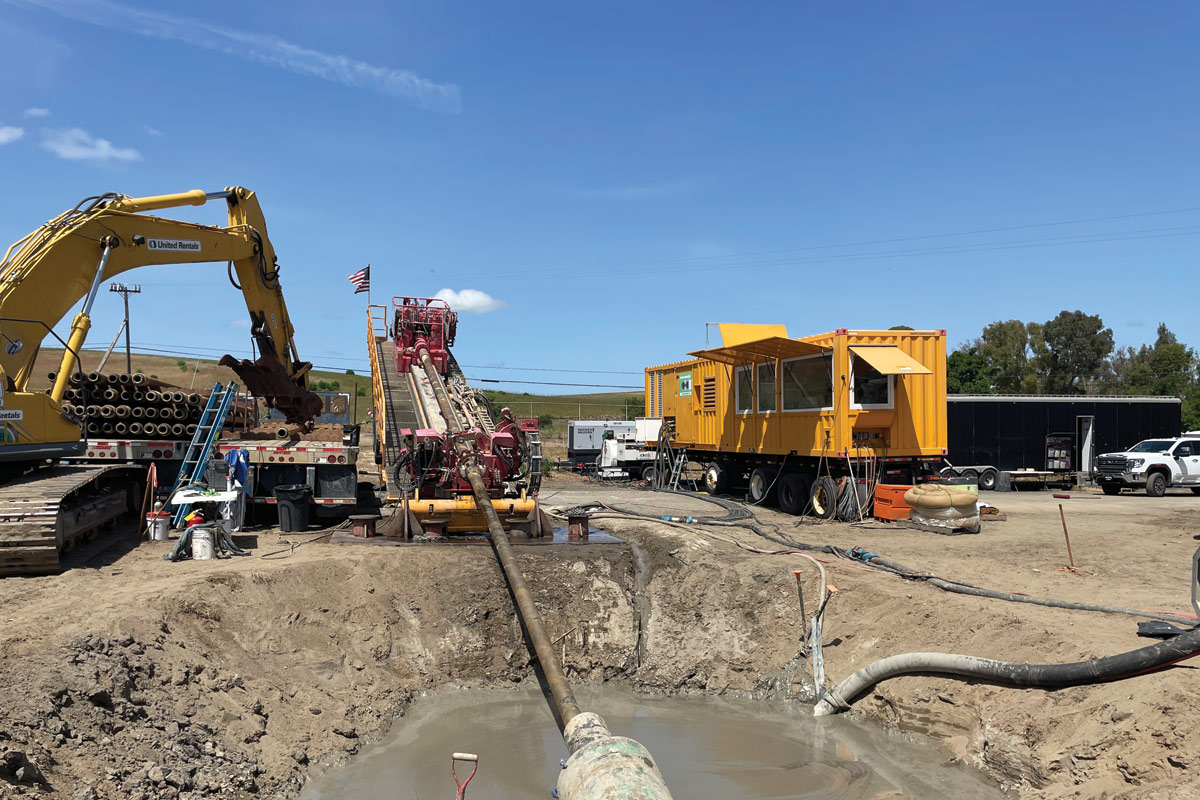The Importance of Bore Planning
Although many HDD jobs don’t require extensive bore planning, there is a great deal of value in taking some basic steps prior to launching that drill head. A quick run through of what the plan is and what can be expected is often a great way to discuss potential and hopefully avoid pitfalls beforehand.
Questions such as: What is the target depth and What does that mean in terms of setback distance should be considered and can often be answered right onsite. This requires familiarity with basic trigonometry, which sounds less intimidating when called rise over run. This simply states that depth change divided by the horizontal distance equals the pitch angle in percent. Another way to look at this is that over a horizontal distance of 20 ft, at a pitch of -10 percent, your depth will increase by 2 ft.
In determining setback distance, depth and pitch information is required. If the target depth is 10 ft, and the average pitch angle is -15 percent, a setback distance of 10ft divided by 0.15 or 67 ft is required. If there is only 60 ft of real estate available on site, the average pitch angle required is 10ft/60ft or -16.7 percent.
The same calculations are used when determining how to best clear that upcoming crossing sewer by the required distance. The current depth of the drillhead, the distance to the sewer and the depth required to clear it will allow the driller to fairly simply calculate what needs to occur. If the requirement is that the drillhead be level under the sewer line, a quick calculation should be done every rod and it is preferable that the steering or pitch changes, as much as is possible, be distributed over the drill rods.
It is important to be familiar with rise over run since it allows the driller to confirm whether the depth his locating equipment is reporting is accurate. If the drill head is at 8 ft of depth, and a 15-ft rod is drilled in at -10 percent, the depth ought to read about 9.5 ft at the end of the rod. If there is significant difference, it could be due to an elevation change over that rod, or it could indicate some level of interference or other reason for the depth readings being off. In either case, the information gained by the quick calculation is valuable.
There is another aspect of bore planning that relates to the pull back, which is after all is the purpose of the exercise. The straighter the bore, the easier the pullback will be. Bores can’t obviously be totally straight but any bends, be they horizontal or vertical, add to the pullback loads. While a smoothly curved bend over a distance is hardly felt, a more abrupt steering change can significantly add to the pullback loads. It is also important to understand the allowable bend radius of the product being pulled back. Steering must take into account the product that is going to have to navigate those same bends.
When engineers run their calculations to estimate pullback loads on a designed bore, they among other things add load factors to account for curves in the bore path. The greater the number of curves or steering corrections along the bore path, the greater the pull force required to pull in the product. It is, therefore, important to minimize the number of course corrections as much as possible.
The formulas for estimating pull back loads are fairly complex and involve some number of assumptions, as well as basic information on the geological conditions. If pullback loads are an issue, due to concerns about the integrity of the installed conduit, there is equipment available that allows the load on the product to be monitored in real time as well as being recorded for documentation. This allows for verification to the owner of the installed conduit that is was not damaged due to over tension during the pullback.
As stated at the outset, many of the HDD installations don’t warrant an engineered project design, but that does not mean than bore planning should be abandoned. Checklists, basic knowledge of rise over run calculations and quick meeting before drilling starts, will go a long way toward increasing the success rate for projects.
Siggi Finnsson is product manager at Digital Control Inc. and is an Electronic Drillmaster Advisory Board member. All Electronic Drillmaster Reports are reviewed by the Advisory Board: Finnsson, John Bieberdorf, The Charles Machine Works Inc.; John Archambeault, McLaughlin Mfg.; and Tod Micheal, Vermeer Corp.




